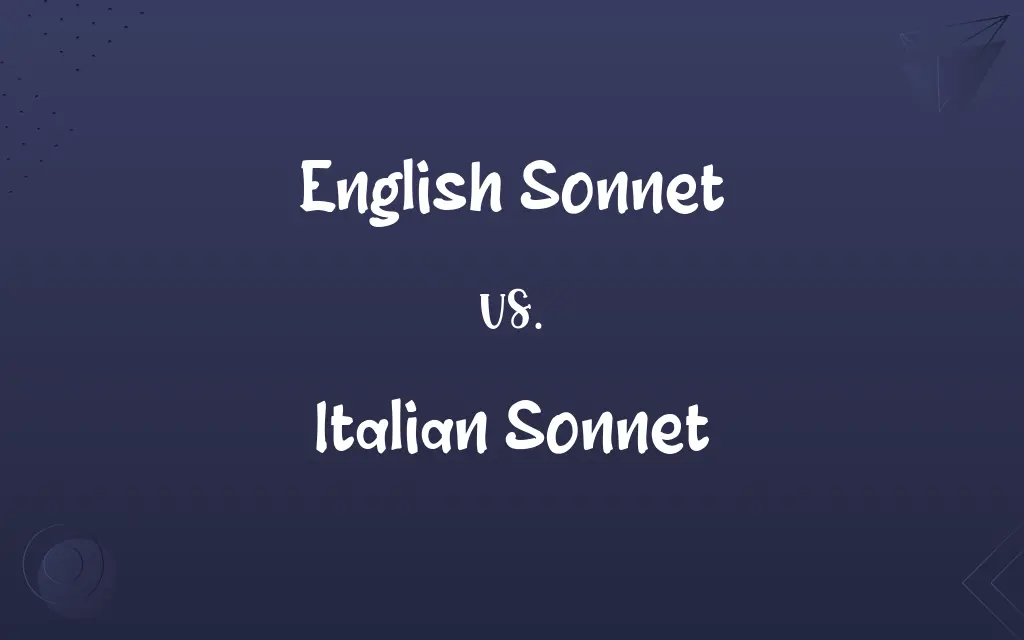English Sonnet vs. Italian Sonnet: Know the Difference

By Hifza Nasir & Shumaila Saeed || Published on April 3, 2024
English sonnets, known for their ABABCDCDEFEFGG rhyme scheme, focus on themes resolved in a final couplet, whereas Italian sonnets, with an ABBAABBACDCDCD pattern, divide into an octave and sestet, presenting a problem and solution.

Key Differences
The English sonnet, also known as the Shakespearean sonnet, is characterized by its structure of three quatrains followed by a final rhyming couplet, allowing for a more gradual development of the poem's theme, which is typically concluded or resolved in the final couplet. The Italian sonnet, or Petrarchan sonnet, is divided into two parts: an octave (the first eight lines) that presents a problem, situation, or emotional state, and a sestet (the last six lines) that offers a resolution, counterargument, or reflection on the octave.
Shumaila Saeed
Apr 03, 2024
The rhyme scheme of the English sonnet (ABABCDCDEFEFGG) offers more flexibility in rhyming and is suited to the English language's fewer rhyming endings, while the Italian sonnet's scheme (ABBAABBACDCDCD or its variations) demands closer attention to the poem's division into two contrasting yet interrelated parts.
Shumaila Saeed
Apr 03, 2024
English sonnets often explore love, beauty, politics, mortality, and nature, with the final couplet providing a poignant or reflective conclusion. Italian sonnets traditionally delve into the complexities of love and moral questions, with the octave and sestet structure allowing for a nuanced exploration of the theme.
Hifza Nasir
Apr 03, 2024
The English sonnet is associated with William Shakespeare, who perfected the form and explored a wide range of human experiences and emotions within its structure. The Italian sonnet traces back to Petrarch, whose sonnets were dedicated to Laura, his idealized beloved, setting the standard for lyrical poetry about unrequited love and beauty.
Dua Fatima
Apr 03, 2024
Both forms have been adapted and used by poets to express a wide range of sentiments and ideas, the structural differences between them reflect distinct approaches to poetic expression, with the English sonnet lending itself to narrative resolution and the Italian sonnet to thematic contrast and reflection.
Hifza Nasir
Apr 03, 2024
ADVERTISEMENT
Comparison Chart
Purpose of Structure
Gradual thematic development and resolution
Presenting a problem and offering a resolution
Shumaila Saeed
Apr 03, 2024
ADVERTISEMENT
Language Suitability
Suited to English's fewer rhymes
Demands precision in rhyme and theme
Shumaila Saeed
Apr 03, 2024
English Sonnet and Italian Sonnet Definitions
English Sonnet
Features a final resolving couplet.
Shakespeare's Sonnet 18 begins with admiration and concludes with eternalizing beauty in verse.
Hifza Nasir
Feb 27, 2024
Italian Sonnet
Influenced European poetry.
Its form has been adopted and adapted by poets across Europe.
Dua Fatima
Feb 27, 2024
English Sonnet
Flexible rhyme schem.
Shakespeare's sonnets explore a variety of themes within the same structural confines.
Shumaila Saeed
Feb 27, 2024
ADVERTISEMENT
Italian Sonnet
Precise rhyme scheme.
The meticulous structure mirrors the intricate nature of the themes explored.
Shumaila Saeed
Feb 27, 2024
English Sonnet
Emphasizes narrative or thematic resolution.
The transition from observation to conclusion in Sonnet 130.
Hifza Nasir
Feb 27, 2024
Italian Sonnet
Presents a problem then resolves it.
Questioning and answering the nature of love's effect.
Hifza Nasir
Feb 27, 2024
English Sonnet
Popular among English poets.
Besides Shakespeare, poets like Milton and Wordsworth have utilized this form.
Shumaila Saeed
Feb 27, 2024
Italian Sonnet
Divides into an octave and sestet.
Petrarch's Sonnet 190, contrasting the pains and pleasures of love.
Hifza Nasir
Feb 27, 2024
English Sonnet
Reflects on human experiences.
Love's enduring power in Sonnet 116.
Hifza Nasir
Feb 27, 2024
Italian Sonnet
Explores lofty ideals and personal emotions.
The idealization of Laura and the introspection this evokes.
Shumaila Saeed
Feb 27, 2024
Repeatedly Asked Queries
How does the final couplet of an English sonnet function?
The final couplet often serves to summarize, conclude, or offer a twist to the poem's narrative or thematic exploration.
Hifza Nasir
Apr 03, 2024
Are there modern examples of these sonnet forms?
Both forms continue to be used and adapted by contemporary poets, demonstrating the flexibility and enduring appeal of the sonnet structure.
Hifza Nasir
Apr 03, 2024
What distinguishes an English sonnet from an Italian sonnet?
The main distinctions are their structures, rhyme schemes, and thematic development, with the English sonnet featuring three quatrains and a final couplet, and the Italian sonnet divided into an octave and sestet.
Hifza Nasir
Apr 03, 2024
Why is the Italian sonnet also called the Petrarchan sonnet?
It's named after Francesco Petrarch, an Italian scholar and poet who popularized the form with his sonnets dedicated to Laura.
Shumaila Saeed
Apr 03, 2024
How do poets choose between an English and Italian sonnet form?
The choice often depends on the poet's thematic intentions, preference for a particular rhyme scheme, and the structural requirements of their poetic argument or narrative.
Dua Fatima
Apr 03, 2024
Can the themes of English and Italian sonnets overlap?
Yes, while each form has its traditional themes, both can explore a wide range of subjects including love, nature, and existential reflections.
Shumaila Saeed
Apr 03, 2024
Has the structure of these sonnets evolved over time?
While the basic structures have remained consistent, poets have experimented with and adapted the forms to suit modern sensibilities and languages.
Hifza Nasir
Apr 03, 2024
Can a sonnet blend elements of both English and Italian forms?
Yes, hybrid forms exist that incorporate elements of both, reflecting the poet's creative exploration of the sonnet tradition.
Shumaila Saeed
Apr 03, 2024
What role does the volta play in sonnets?
The volta, or turn, signifies a shift in argument, perspective, or emotion, typically occurring between the octave and sestet in Italian sonnets and often near the final couplet in English sonnets.
Shumaila Saeed
Apr 03, 2024
How does the choice of language affect the sonnet form?
The linguistic characteristics, such as the abundance or scarcity of rhymes in a language, can influence how effectively a sonnet's rhyme scheme is executed and may affect the poet's choice of form.
Dua Fatima
Apr 03, 2024
Share this page
Link for your blog / website
HTML
Link to share via messenger
About Author
Written by
Hifza NasirCo-written by
Shumaila SaeedShumaila Saeed, an expert content creator with 6 years of experience, specializes in distilling complex topics into easily digestible comparisons, shining a light on the nuances that both inform and educate readers with clarity and accuracy.








































































